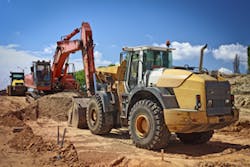The Importance of Hydraulics and Maintenance
The size of the excavator you choose is obviously important, but there is more to an excavator than its size. What attachments can it handle? Excavators can help increase productivity on any project requiring craning utilities into place overhead or burying underground, digging, compacting, and backfilling trenches, breaking up concrete, and digging postholes with the appropriate attachment. “No matter what attachment an operator is using, the key to productivity is to make sure the machine’s hydraulic flow is matched to the attachment, and that it is easy for operators to change out and operate the attachment,” advises Jamie Wright, product manager at Terex Corp. America. “For instance, quick-coupler systems make it fast and easy to change attachments, and auxiliary hydraulics offer flexibility in adding attachments. Terex excavators are engineered with an auxiliary hydraulic circuit that has an open return and are plumbed out to the dipper stick. This provides customers with immediate dual function capability [i.e., no switching back and forth]. Terex excavators use load-sensing hydraulics to provide excellent multitasking capabilities for the boom, dipper, and attachment.”
“A modern hydraulic system will allow the operator to run boom, stick, and swing functions in a precise, smooth, and efficient manner,” explains Wright. On today’s popular compact excavators, the hydraulic system gives the operator powerful breakout and lift forces to complete tough jobs with low effort and smooth joystick control movement. “For the most part, the basics of a hydraulic system, whether on an excavator, tractor loader backhoe, or skid-steer loader, are the same. Hydraulic machines have the same components: the engine, hydraulic pump, hydraulic valve, hydraulic motors, and hydraulic cylinders. For excavators, to run multiple functions simultaneously (such as curling the bucket, raising the boom, and swinging the upper carriage) hydraulic motors and multiple cylinders are needed.
Load-independent flow division has hydraulic oil supplied to the motors and cylinders, per operator commands, without regard to what other functions are being operated. This allows the operator to multitask without losing power because the oil is able to flow to multiple functions simultaneously. It is an invaluable asset in an excavator’s internal workings. Terex uses a load-sensing system in its compact excavators that permits the axial piston pump to respond to changes in the load without overloading the engine. First of all, this saves fuel! It also extends the life of the machine’s components. With a load-sensing system, the pump senses the operator’s commands and directs the flow of oil to that chosen function, without stopping the other functions.
Here’s some excellent advice to consider. “Ease of maintenance is critical, as contractors (or their dealers) will spend a lot of time greasing joints, changing filters, and checking fluids throughout the life of that machine,” we are reminded by Brad Stemper, solutions marketing manager for Case Construction Equipment. “Look for machines that simplify maintenance by positioning daily service points in easy-to-reach areas. Ultimately, this will help you minimize downtime related to equipment upkeep.”
“It’s also important to have a good understanding of total cost of ownership when you go out to buy a machine,” adds Stemper. “The purchase price is often the baseline, but each dealer and manufacturer has different incentives and programs aimed at removing as much of that variability in equipment ownership costs as possible. This includes warranties and dealer service contracts aimed at allowing contractors to buy equipment and to budget for it properly, knowing those equipment costs won’t change within a certain amount of time. Similarly, telematics subscriptions can be bundled with these programs to provide contractors with yet another tool to help keep equipment costs down, monitor equipment maintenance and productivity, and provide a better overall understanding of equipment utilization.”
The Impact of Compacts
It’s not many years ago (some of you were still in school) that an excavator was perceived as a largepiece of construction equipment; the development of compact excavators changed that. There are certainly enough models of compact excavators to make the choice of an excavator a whole new challenge. “One of the first questions to answer is whether you need a compact excavator,” suggests Tom Connor, excavator product specialist for Bobcat Co. “If you frequently rent a compact excavator or subcontract work done by compact excavators, then you can probably justify adding one to your equipment fleet. Generally, construction contractors will find more uses than anticipated for the machine once it’s in their possession.” It’s important to assess maximum utilization of the machine. “Does the manufacturer offer attachments, and does the dealer stock them?” asks Connor. “Does the machine have an easy-to-use attachment mounting system? Is the machine designed to accommodate a hydraulic clamp?”
It isn’t only the sheer size of an excavator that matters. Often it is the way the machine is operated, the way the operator must guide it, and the way it gets to its work site that matters. With many construction jobs done on property where access is difficult—and that can be at a residential project or downtown with narrow streets and alleys—the configuration can be significant. Some manufacturers (like Bobcat in the M-Series 324 and 418) offer retractable undercarriages, which allow the operator to retract the undercarriage, go through a gate or fence, and then expand the undercarriage when working. Production is a key word, and the owner of an excavator wants as much as possible from the model he or she chooses. Some smaller excavators have power that would have been unimaginable a few years ago, with breakout forces and digging depths traditionally associated with larger machines, and even long-arm or extendable arm options.
“If lifting 1,000-pound spools will be a frequent, recurring task for the excavator, then one needs to select a machine that will accomplish this comfortably,” notes Connor. “If minimum cover is 8 feet, one should be looking at a machine capable of digging 10 to 12 feet to achieve decent production.”








